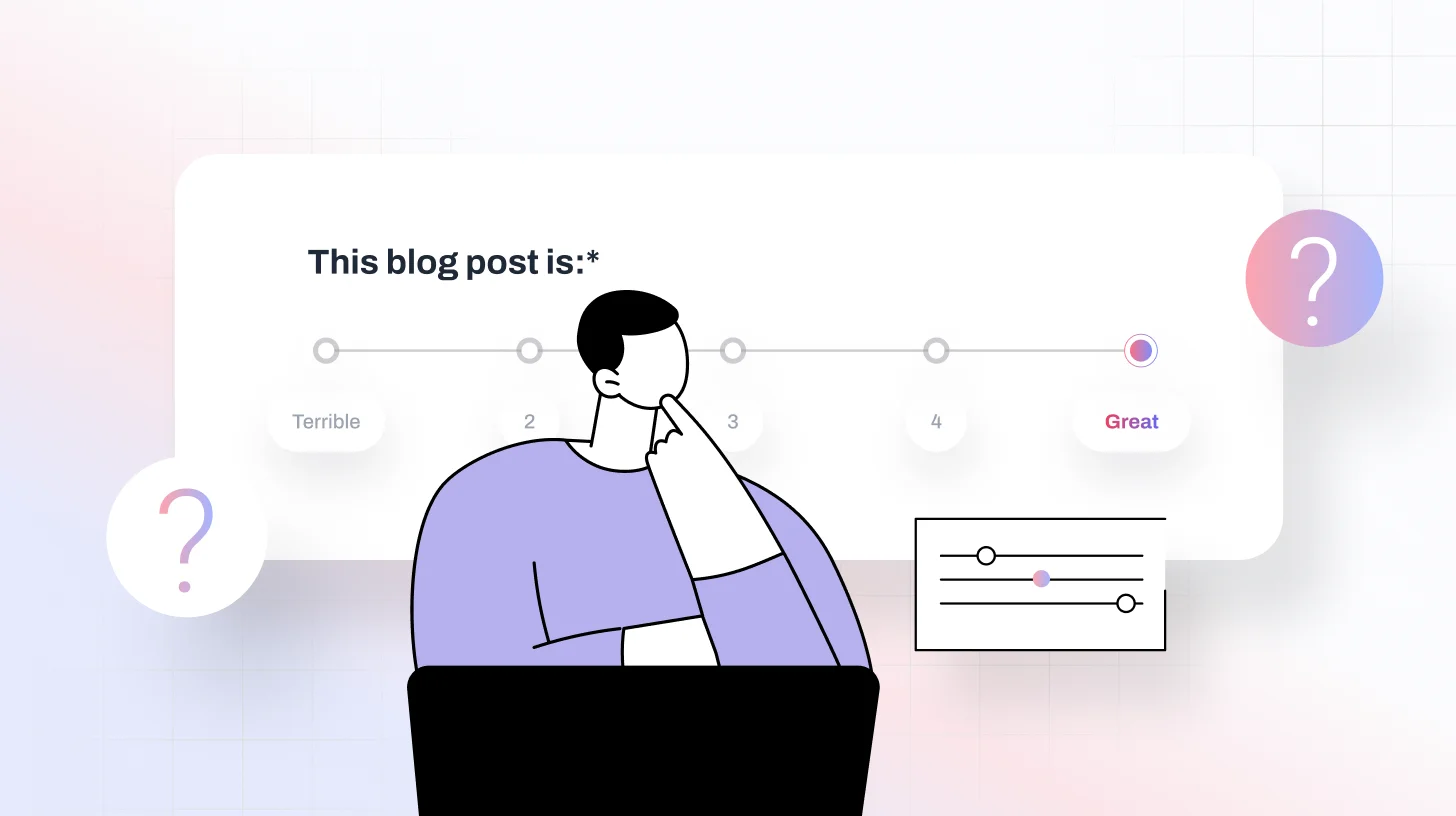 Blog
Blog Staff Engagement Survey: 70+ Questions, Free Template & Best Practices
Staff Engagement Survey: 70+ Questions, Free Template & Best PracticesStaff Engagement Survey: 70+ Questions, Free Template & Best Practices

Every business leader wants a team that shows up motivated, performs with energy, and feels genuinely connected to their work. Engaged employees don’t just meet expectations, they exceed them, driving higher productivity, stronger customer experiences, and long-term business growth.
But here’s the challenge: leaders often see engagement differently from employees. Many executives assume their workforce is motivated, yet survey after survey shows that actual employee engagement levels are far lower than expected. This disconnect leads to missed opportunities, turnover, and a culture where people feel unheard.
A well-designed staff engagement survey helps bridge that gap. By asking thoughtful questions, you gain honest insights into what your employees value, what frustrates them, and how leadership can better support them. When employees feel heard, they respond with higher commitment, creativity, and loyalty.
That’s why we’ve created this guide: a comprehensive list of 70+ staff engagement survey questions, organized into practical categories and paired with a free template you can use right away. Whether you’re leading HR, product, or customer success, these questions will help you move beyond guesswork and start building a workplace where people thrive.
TL;DR: Staff Engagement Surveys
- Staff engagement surveys measure how motivated, satisfied, and aligned employees feel at work.
- Engaged staff = higher productivity, lower turnover, and stronger culture.
- This guide includes 70+ best-practice survey questions across topics like culture, leadership, DEI, remote work, and development.
- Use a mix of quantitative (scalable) and qualitative (open-ended) questions for actionable insights.
- With TheySaid AI surveys, you get real-time analytics, sentiment tracking, and benchmarks to turn feedback into measurable results.
- A free staff engagement survey template is included to get started quickly.
What is a Staff Engagement Survey?
A staff engagement survey is a structured questionnaire designed to measure how committed, motivated, and connected employees feel to their work and the organization. Unlike simple satisfaction surveys that focus on whether employees are “happy” at work, engagement surveys dig deeper, exploring how invested staff are in their roles, whether they believe in company goals, and how likely they are to stay and grow with the organization.
At its core, engagement isn’t just about perks or paychecks. It’s about whether employees:
- Feel their work has meaning and impact.
- Trust their leaders and managers.
- Believe their voices are heard.
- Have opportunities for growth and recognition.
A staff engagement survey collects this insight in a measurable way, helping HR leaders, executives, and managers understand the health of workplace culture. By tracking these results over time, companies can identify patterns, address pain points, and make data-driven decisions that improve both employee retention and overall performance.
Also Read: Top Employee Engagement Survey Topics (What to Ask & Why It Matters)
Staff Engagement: The Stats
Numbers don’t lie. Employee engagement has a direct impact on performance, retention, and business outcomes. Yet, the data shows a persistent gap between how leaders perceive engagement and how employees actually feel.
Here are some key statistics that highlight why running a staff engagement survey is no longer optional in 2025:
- Only 23% of employees worldwide are engaged at work (Gallup, 2024). That means nearly 3 out of 4 employees are not motivated or fully committed.
- Actively disengaged employees cost companies 18% of their annual salary in lost productivity (Gallup, 2023). For a 500-person company, that can mean millions lost every year.
- 63% of disengaged employees are more likely to quit within 12 months (LinkedIn Workplace Learning Report, 2024). Engagement and retention are inseparable.
- Organizations with high staff engagement see 21% higher profitability and 17% higher productivity compared to those with low engagement (Gallup, 2023).
- Hybrid and remote workers report 12% lower engagement than on-site peers when leadership fails to maintain communication and recognition (McKinsey, 2024).
What these numbers reveal is simple: disengagement is costly, but it’s preventable. With regular, well-designed staff engagement surveys, leaders can identify weak spots early, strengthen culture, and drive measurable business results.
Types of Staff Engagement Surveys
Different surveys serve different purposes, depending on how often you want feedback and what insights you’re looking for. Here are the main types:
1. Pulse Surveys
- Short, frequent surveys (weekly or monthly).
- Designed to quickly gauge employee sentiment on specific topics.
- Ideal for monitoring trends and spotting issues early.
2. Annual or Comprehensive Surveys
- Longer, in-depth surveys are conducted once a year.
- Covers all aspects of employee engagement, including satisfaction, communication, management, and career growth.
- Provides a broad overview of the organization’s engagement health.
3. 360-Degree Feedback Surveys
- Collects feedback from multiple sources: peers, subordinates, and managers.
- Offers a complete perspective on employee performance and workplace relationships.
- Useful for leadership development and team dynamics analysis.
Read - 70+ 360 Degree Feedback Questions for Better Performance Reviews
4. Onboarding or Exit Surveys
- Onboarding surveys: Capture feedback from new employees to improve the integration process.
- Exit surveys: Gather insights from departing employees to understand reasons for turnover and identify improvement areas.

70+ Staff Engagement Survey Questions [+ Free Template]
A staff engagement survey is only as powerful as the questions you ask. To truly understand how your people feel about their work, culture, and future at your company, you need clear, meaningful, and well-structured prompts.
We’ve prepared a free question set that covers multiple areas of the employee experience from performance and culture to leadership, diversity, and remote work. These questions combine quantitative prompts (easy-to-measure rating scale items) with qualitative questions (open-ended reflections) so you get both the “what” and the “why” behind engagement trends.
General Performance & Engagement
- I would recommend [Company] as a great place to work.
- I see myself still working at [Company] in two years.
- Most days, I feel a strong sense of accomplishment in my role.
- I have opportunities to take on challenging and meaningful tasks.
- I clearly understand what’s expected of me to succeed.
- I know how my work supports the company’s goals.
- The company's strategy inspires me and feels like the right direction.
- Leadership communicates goals and strategy effectively.
- My workload feels manageable and sustainable.
- I can take time off when needed without feeling guilty.
Company Culture & Environment
- My workplace enables me to stay focused and productive.
- I have access to spaces (physical or digital) for effective collaboration.
- Open and honest communication is valued here.
- My manager actively listens to my opinions.
- My colleagues are open to perspectives different from their own.
- My manager provides the support I need to succeed.
- I feel that my well-being is a genuine priority at [Company].
- I connect with and identify with the company’s values.
- Team members can raise problems without fear of judgment.
- It is safe to take risks and share new ideas.
- Employees can voice their opinions freely.
- The work I do feels meaningful.
- I make a positive impact on my team.
Employee Development & Growth
- I am given the freedom to decide how to do my work.
- I have access to the tools and information I need.
- My role allows me to learn and develop new skills.
- I see clear career growth opportunities at [Company].
- My manager or mentor actively supports my development.
- I feel part of a collaborative team.
- I can rely on colleagues when I need help.
- Our team holds each other accountable for results.
- Good work is recognized and appreciated here.
- I receive enough feedback to improve and grow.
- I feel fairly rewarded for my contributions (salary, promotion, training).
- Pay and reward processes feel transparent and unbiased.
- I can discuss salary and performance openly with my manager.
- Open-ended: What can we do to better support your professional growth?
Diversity, Equity & Inclusion (DEI)
- [Company] fosters a diverse and inclusive environment.
- Leaders are visibly committed to diversity and equity.
- People from all backgrounds have equal opportunities to succeed.
- Individuals from different backgrounds are respected here.
- Diverse perspectives are included in decision-making.
- I feel like I belong at [Company].
- My uniqueness is recognized and valued.
- My workplace accommodates my individual needs.
- Open-ended: What could we do to improve inclusivity at [Company]?
Remote & Hybrid Work
- I feel productive when working remotely.
- Remote work does not harm collaboration in my team.
- I feel connected to my team while working remotely.
- I can maintain a healthy work-life balance from home.
- Remote work positively supports my overall well-being.
- My manager checks in regularly while I work remotely.
- I have the right tools and environment to succeed remotely.
- Open-ended: What additional support would improve your remote work experience?
Leadership & Change Management
- Leaders at [Company] communicate openly about changes.
- I trust leadership to make decisions in the best interest of employees.
- I feel included in decisions that affect my work.
- Change is managed effectively here.
- Leaders demonstrate empathy and transparency during challenges.
- Open-ended: How can leadership improve communication and trust?
Recognition & Motivation
- I feel appreciated for the work I do.
- Recognition here feels meaningful, not just routine.
- My achievements are celebrated by my team.
- Open-ended: What type of recognition motivates you most?
Wellbeing & Balance
- I feel my mental health is supported at work.
- [Company] offers adequate resources for health and wellness.
- I feel energized and motivated most days.
- My workload allows me to maintain a healthy personal life.
- Open-ended: What can we do to better support your well-being?
- I feel comfortable discussing stress or burnout with my manager.
- [Company] actively encourages practices that promote work-life balance (e.g., flexible hours, time off, wellness initiatives).
Essential Steps for Running a Successful Staff Engagement Survey
Free Staff Engagement Survey Template
Here’s a quick, ready-to-use staff engagement survey template with 8 essential questions to help you gather honest feedback and measure how your team really feels.
1. How likely are you to recommend [Company] as a great place to work?
- 0 (Not at all likely) → 10 (Extremely likely)
2. I feel my contributions at work are valued.
- Strongly disagree
- Disagree
- Neutral
- Agree
- Strongly agree
3. Do you clearly understand how your role connects to [Company]’s goals?
- Yes, completely
- Somewhat
- Not really
- Not at all
4. How satisfied are you with the communication from your manager?
- Very dissatisfied
- Dissatisfied
- Neutral
- Satisfied
- Very satisfied
5. What’s the one thing [Company] could do to improve your experience at work?
(Open text field)
6. I have access to the tools and resources I need to do my job effectively.
- Strongly disagree
- Disagree
- Neutral
- Agree
- Strongly agree
7. How would you rate your overall work-life balance?
- Very poor
- Poor
- Fair
- Good
- Excellent
8. In the past month, how often have you felt recognized for your work?
- Never
- Rarely
- Sometimes
- Often
- Always

Why Use TheySaid for Your Staff Engagement Surveys?
Traditional surveys capture answers. TheySaid captures conversations. That difference is why top revenue leaders, product executives, and customer success teams are switching to AI-powered staff engagement surveys.
Here’s what makes TheySaid different:
- Real Conversations, Not Checkboxes: Our AI listens, asks clarifying follow-ups, and uncovers what employees really mean, turning surface-level data into deep insights.
- Actionable Insights in Real Time: No more waiting weeks for survey reports. TheySaid delivers real-time sentiment analysis, trend detection, and priority recommendations, so leaders know where to act now.
- Built for Managers, Not Just HR: Every manager can run tailored staff engagement surveys, track team-level performance, and take action backed by data.
- Predictive Retention Signals: TheySaid identifies early warning signs of disengagement and attrition risk, helping you reduce costly turnover before it happens.
- Benchmarking That Matters: Compare your engagement results with industry peers and SaaS benchmarks to see exactly where your teams stand.
- Scalable AI Feedback Engine: Whether you have 50 or 50,000 employees, TheySaid scales effortlessly while keeping feedback authentic and personalized.
Staff engagement surveys with TheySaid don’t just collect opinions. They create a feedback loop that continuously improves culture, performance, and retention.
FAQs
Why are staff engagement surveys important?
Engagement surveys provide insights into employee satisfaction, productivity, and retention. They help leaders make data-driven decisions to improve workplace culture and overall performance.
How often should organizations conduct engagement surveys?
It depends on your goals. Many companies use a combination of:
- Pulse surveys: Short, frequent surveys to track trends.
- Annual surveys: Comprehensive, in-depth surveys for overall insights.
How long should a staff engagement survey take to complete?
A typical survey should take 10–15 minutes. Shorter surveys encourage participation, while longer, detailed surveys are better for annual or comprehensive feedback.
Can staff engagement surveys be anonymous?
Yes! Anonymity encourages honest feedback and higher participation rates. Clearly communicate whether responses are anonymous to employees.
What types of questions should be included?
Include a mix of:
- Rating-scale questions (e.g., 1–10 satisfaction)
- Multiple-choice questions
- Open-ended questions for qualitative feedback















.svg)